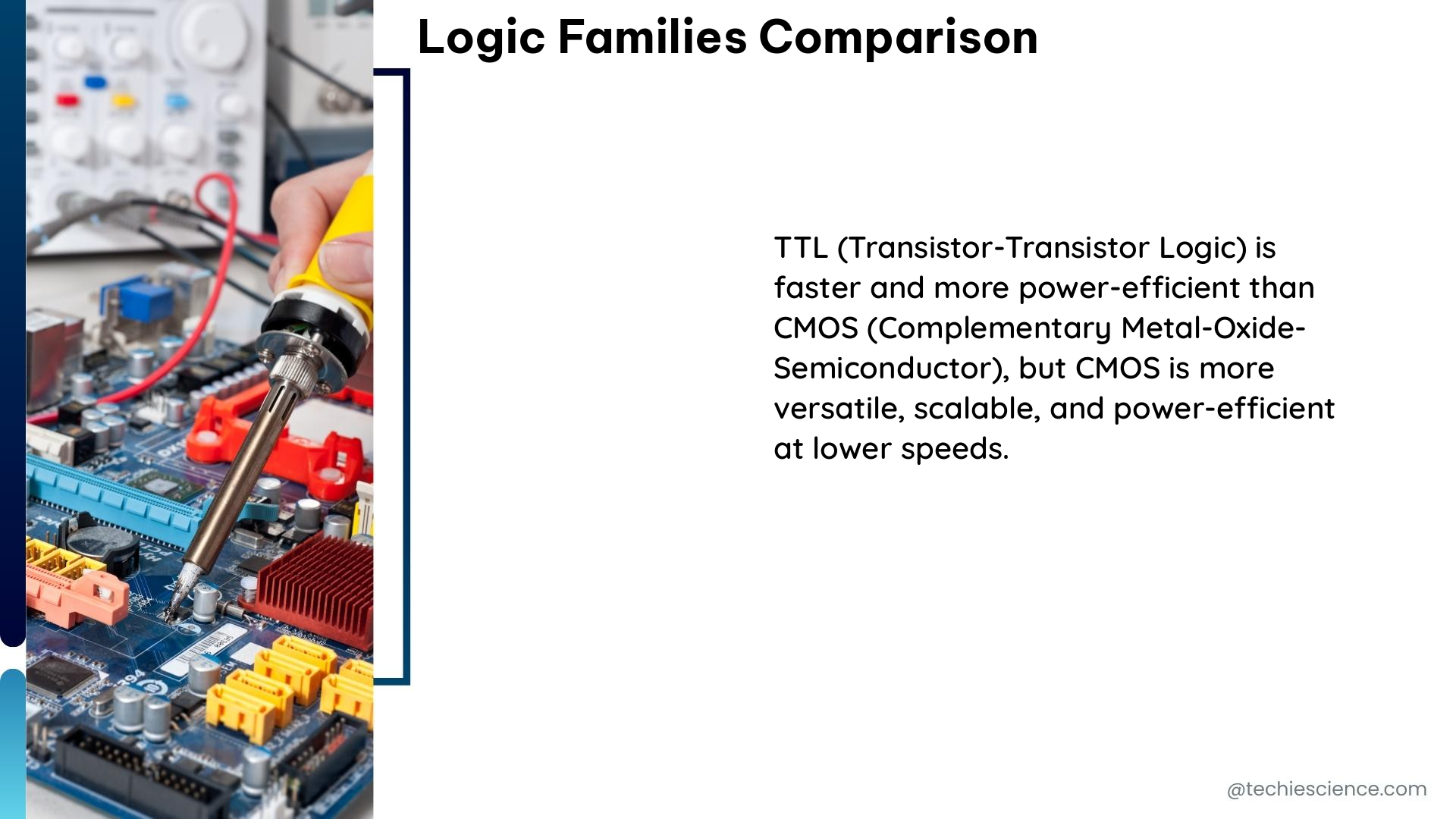In the realm of digital electronics, the choice of logic family is a crucial decision that can significantly impact the performance, power consumption, and overall design of a system. Logic families are collections of integrated circuits that share similar characteristics, and understanding their nuances is essential for electronics engineers and students alike. This comprehensive guide delves into the technical details of various logic families, providing a thorough comparison to help you make an informed decision.
Transistor-Transistor Logic (TTL)
Transistor-Transistor Logic (TTL) is one of the most widely used logic families, known for its speed and reliability. Here’s a closer look at its key specifications:
Logic Levels:
– Supply Voltage (Vcc): 5V
– High-Level Output Voltage (Voh): 2.4V to 5V
– Low-Level Output Voltage (Vol): 0.4V to 0.8V
Power Dissipation:
– Range: 10mW to 100mW per gate
– TTL gates typically consume more power than other logic families, making them less suitable for low-power applications.
Propagation Delay:
– Range: 10ns to 30ns
– TTL gates are relatively fast, with propagation delays in the nanosecond range, making them suitable for high-speed digital circuits.
Noise Margin:
– Noise Margin: 0.4V
– TTL gates have a moderate noise margin, providing reasonable immunity to electrical noise.
Fan-Out:
– Fan-Out: 10
– TTL gates can drive up to 10 standard TTL inputs, making them suitable for driving multiple loads.
Complementary Metal-Oxide-Semiconductor (CMOS)

Complementary Metal-Oxide-Semiconductor (CMOS) logic is another widely used family, known for its low power consumption and high noise immunity.
Logic Levels:
– Supply Voltage (Vcc): 3V to 15V
– High-Level Output Voltage (Voh): 0.7Vcc
– Low-Level Output Voltage (Vol): 0.3Vcc
Power Dissipation:
– Static Power Dissipation: 1µW to 1mW per gate
– Dynamic Power Dissipation: 10mW to 100mW per gate
– CMOS gates have significantly lower static power consumption compared to TTL, making them suitable for low-power applications.
Propagation Delay:
– Range: 10ns to 100ns
– CMOS gates are generally slower than TTL gates, with propagation delays in the range of 10ns to 100ns.
Noise Margin:
– Noise Margin: 0.3Vcc
– CMOS gates have a higher noise margin compared to TTL, providing better immunity to electrical noise.
Fan-Out:
– Fan-Out: 50
– CMOS gates can drive up to 50 standard CMOS inputs, making them suitable for driving larger loads.
Emitter-Coupled Logic (ECL)
Emitter-Coupled Logic (ECL) is a high-speed logic family, primarily used in applications where speed is the primary concern.
Logic Levels:
– Supply Voltage (Vcc): -5.2V
– High-Level Output Voltage (Voh): -1.7V to -0.9V
– Low-Level Output Voltage (Vol): -1.9V to -2.1V
Power Dissipation:
– Range: 100mW to 200mW per gate
– ECL gates consume significantly more power than TTL and CMOS, making them less suitable for low-power applications.
Propagation Delay:
– Range: 1ns to 5ns
– ECL gates are the fastest among the logic families discussed, with propagation delays in the range of 1ns to 5ns.
Noise Margin:
– Noise Margin: 0.2V
– ECL gates have a relatively low noise margin compared to TTL and CMOS, requiring more careful design considerations to mitigate noise issues.
Fan-Out:
– Fan-Out: 5
– ECL gates can drive up to 5 standard ECL inputs, which is lower than TTL and CMOS.
Comparison of Speed-Power Product
The speed-power product is a crucial metric that combines the propagation delay and power dissipation of a logic family, providing a measure of its overall performance. A lower speed-power product indicates better performance.
TTL Gates:
– Speed-Power Product: 0.1W-ns to 3W-ns
CMOS Gates:
– Speed-Power Product: 0.001W-ns to 10W-ns
The comparison shows that TTL gates have a lower speed-power product, indicating faster performance, but they also consume more power. Conversely, CMOS gates have a higher speed-power product, indicating slower performance, but they consume significantly less power.
Choosing the Right Logic Family
When selecting a logic family for your design, it’s essential to consider the specific requirements of your application, such as speed, power consumption, noise immunity, and fan-out. By understanding the technical details and trade-offs of each logic family, you can make an informed decision that best suits your project’s needs.
For example, if your design requires high-speed performance, ECL might be the best choice, despite its higher power consumption. On the other hand, if power efficiency is a primary concern, CMOS logic would be the more suitable option, even with its slower propagation delays.
By carefully evaluating the characteristics of each logic family and aligning them with your design requirements, you can optimize the performance, power efficiency, and overall reliability of your digital electronics project.
References:
- Boolean Algebra and Simplification Techniques – 5 Logic Families
- Aligning Data and Measures to Outputs and Outcomes of the Logic Model
- B sc cs i bo-de u-iv logic families | PPT – SlideShare
- Introduction to Logic Family – GeeksforGeeks
- Logic families | PPT – SlideShare

The lambdageeks.com Core SME Team is a group of experienced subject matter experts from diverse scientific and technical fields including Physics, Chemistry, Technology,Electronics & Electrical Engineering, Automotive, Mechanical Engineering. Our team collaborates to create high-quality, well-researched articles on a wide range of science and technology topics for the lambdageeks.com website.
All Our Senior SME are having more than 7 Years of experience in the respective fields . They are either Working Industry Professionals or assocaited With different Universities. Refer Our Authors Page to get to know About our Core SMEs.